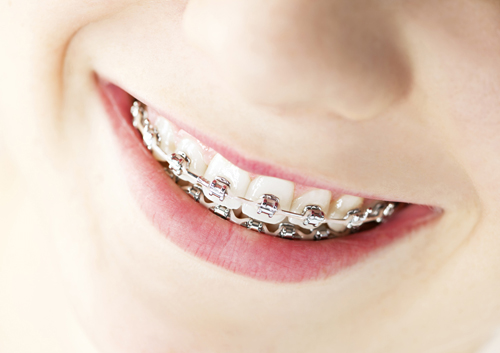January 31st, 2024

In recent years, many links have been established between orthodontic treatments and whole body health. According to the National Institute of Dental and Craniofacial Research, researchers have observed that people with gum disease are more likely to develop heart disease or experience difficulty controlling blood sugar than people without gum disease. While researchers continue to find associations between oral health and the overall health of the body, as of yet it hasn’t been determined whether gum disease is the sole cause of these health conditions. What can be determined, however, is that good oral health isn't just about maintaining a healthy smile; it has an impact on the health of your entire body.
The associations between gum disease and whole body health
The links between the health of your mouth and the health of your body are too many to ignore. Is it a coincidence that gum disease and other health problems occur together? Researchers don’t think so, despite the lack of definitive proof.
Here are four possible connections between the health of your mouth and the health of your body.
- Excessive oral inflammation has been linked to a greater incidence of clogged arteries.
- The American Society of Microbiology has revealed that certain types of oral bacteria can infect the arterial cells and weaken the wall of the heart.
- Loose teeth are often believed to be a warning sign for osteoporosis, a disease that causes the bones to become less dense.
- Some studies suggest women with gum disease are more likely than those without gum disease to deliver preterm, low-weight babies.
Orthodontics and gum disease
So what does undergoing orthodontic treatment at our office have to do with gum disease? Braces do so much more than give you a nice-looking smile. Quite simply, straight teeth are easier to keep clean than crooked teeth. Your toothbrush is able to remove more plaque-causing bacteria, and your floss is more effective at ridding tiny particles between your teeth.
Despite the lack of hard facts in these findings, the message is clear: If you improve your oral health, you will also have a greater chance of maintaining the health of your entire body. And that’s a chance Dr. Mark L. M. Powell and our team at our office believe is worth taking. For more information about this topic, please give us a call at our convenient Jenison, MI office or ask Dr. Mark L. M. Powell during your next visit!
January 31st, 2024

Brushing your teeth regularly is one of the most crucial parts of maintaining good oral health, and perhaps the most fundamental, however, there are also other elements involved. Flossing, for instance, is also vital; some experts would say, and Dr. Mark L. M. Powell and our team would agree, that it holds just as much importance as brushing your teeth. To give you a better idea of why, here are some reasons that flossing is so vital to your oral health.
Getting in-between the Teeth
While brushing your teeth effectively cleans all of the areas of your teeth that are visible, or otherwise not touching, flossing is vital because it reaches all of the areas between your teeth that you cannot see, and subsequently cannot clean using a toothbrush. These areas are among the most sensitive and vulnerable parts of your mouth because they are most susceptible to plaque and tartar buildup.
Reducing Bad Breath
It is not uncommon for someone who brushes their teeth once or twice a day to still have bad breath. The reason being is that bad breath is often created by smelly bacteria that lives in between your teeth, as well as other areas of your mouth that are not accessible using a toothbrush. And that is why flossing is one of the best ways to reduce or eliminate bad breath. Still skeptical? Try flossing your teeth with unscented floss, then smell it after, that awful scent is the source of your bad breath. Coupled with frequent brushing of your teeth, you will find that flossing can really help that stinky breath.
Brushing your teeth twice a day is hard enough, add flossing on top and it can be difficult to establish a regular habit. However, doing so is totally worth it; just look at the aforementioned reasons why. Use these for motivation the next time you don’t feel like flossing, and let us know if it worked at your next visit to our Jenison, MI office.
January 24th, 2024

If you’ve been hiding your smile because you have crooked teeth or gaps between your teeth, it’s time to consider orthodontic treatment with Dr. Mark L. M. Powell. Preparing for treatment is an important part of getting the smile you want.
Basic exams
The first step of preparation is the examination. An oral exam and X-rays taken at our office are necessary to identify potential problems and ensure the right steps are taken to prepare for orthodontic treatment at our office.
Dr. Mark L. M. Powell will first examine your teeth and take X-rays to determine if it is necessary to extract any teeth or additional work is necessary before braces are possible. You will be prepared for the next step of treatment after your exam is complete and potential problems are identified.
Model for bite
The next step in preparing for orthodontic is taking a plaster model of the mouth. With the model, Dr. Mark L. M. Powell will be able to determine how the jaw is aligned so that appropriate adjustments can be made to the mouth and jaw with braces.
Depending on the situation, the model may be used to help evaluate your jaw and make decisions about appropriate treatment for your specific needs. Dr. Mark L. M. Powell can create a model of your mouth with the bite indentation that is taken during preparation.
Extracting teeth
If it is determined that a tooth extraction is necessary, then the final step of preparing for orthodontic treatment is the removal of teeth. Only Dr. Mark L. M. Powell can determine if it is necessary to remove any teeth before moving forward with the procedure to put on braces.
When your teeth are crooked, have a gap, or otherwise make you unhappy, orthodontic treatment at our office may be an appropriate solution. Although it may take time to prepare for the actual procedure, making the decision to seek treatment can provide the opportunity to show the world a beautiful smile.
For more information about orthodontic treatment and its benefits, or to schedule a consultation with Dr. Mark L. M. Powell, please give us a call at our convenient Jenison, MI office!
January 24th, 2024

You found the perfect toothbrush! The bristles are soft, to avoid irritating your delicate gum tissue. The angle of the bristles is perfect for removing plaque. The handle is durable and comfortable when you spend at least two minutes brushing in the morning and two at night. Why, you love this toothbrush and you’ll never let it go… for the next three or four months.
The life of a toothbrush is naturally a short one. Dr. Mark L. M. Powell and our team recommend replacement every three to four months because the bristles become frayed and worn with daily use. They cannot clean as effectively when the bristles begin to break down, and, depending on your brushing style, may wear out even more rapidly. (Children will probably need to replace toothbrushes at least every three months.) But even in the short time you have your toothbrush, there are ways to keep it ready for healthy brushing.
- Don’t share. While sharing is normally a virtue, sharing toothbrushes can lead to an increased risk of infections, especially for those with compromised immune systems or existing infectious diseases. Similarly, keep different brushes separate when drying to avoid cross-contamination.
- Rinse thoroughly after brushing. Make sure to remove any toothpaste or debris left after you brush.
- Store the brush upright. Air-drying is the preferred way to dry your brush, as covering the brush or keeping it in a closed container can promote the growth of bacteria more easily.
There are several products on the market that promise to sanitize your brush. The verdict is still out on its success, but if you or someone in your home has a compromised immune system, call our Jenison, MI office to see if it might be worth your while to check them out.
Even though your toothbrush won’t be with you long, make its stay as effective and hygienic as possible. And if you find a brush you love—stock up!





 Website Powered by Sesame 24-7™
Website Powered by Sesame 24-7™